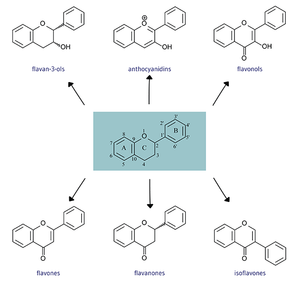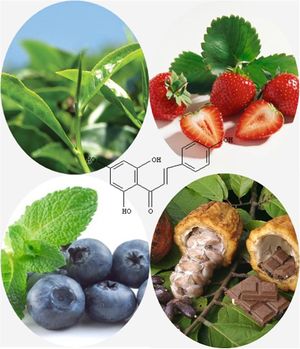Flavonoids: Difference between revisions
No edit summary |
|||
| Line 3: | Line 3: | ||
==Chemical structures== | ==Chemical structures== | ||
[[File:Flav structures 2.0.png|thumb|Six subgroups of Flavonoids separated by chemical structure]] | [[File:Flav structures 2.0.png|thumb|Six subgroups of Flavonoids separated by chemical structure]] | ||
All flavonoids consist of phenolic and pyrane rings and are generally insoluble. [2] Flavonoids differ in the arrangement of hydroxyl, methoxy, and glycosidic groups around a flavin backbone and from there form subgroups that include more specific chemicals. [ | All flavonoids consist of phenolic and pyrane rings and are generally insoluble. [2] Flavonoids differ in the arrangement of hydroxyl, methoxy, and glycosidic groups around a flavin backbone and from there form subgroups that include more specific chemicals. [1] | ||
'''Flavones''' -Apigenin, Luteolin | '''Flavones''' -Apigenin, Luteolin | ||
| Line 14: | Line 14: | ||
'''Anthocyanidins''' -Cyanidin, Delphinidin, Malvidin, Pelargonidin, Peonidin, Petunidin | '''Anthocyanidins''' -Cyanidin, Delphinidin, Malvidin, Pelargonidin, Peonidin, Petunidin | ||
==Role in plant growth== | |||
=== Rhizosphere === | |||
==Presence in foods== | ==Presence in foods== | ||
| Line 19: | Line 22: | ||
Flavonoids have been discovered to play a big role in the presence of antioxidants in common food sources. The five subgroups of flavonoids above exist as antioxidants within a multitude of common food items. [4] | Flavonoids have been discovered to play a big role in the presence of antioxidants in common food sources. The five subgroups of flavonoids above exist as antioxidants within a multitude of common food items. [4] | ||
Flavonols are found heavily in black tea and raw onions as well as in beer, coffee, and tomatoes. [4] Bee pollen has also found to contain flavonols. [ | Flavonols are found heavily in black tea and raw onions as well as in beer, coffee, and tomatoes. [4] Bee pollen has also found to contain flavonols. [5] | ||
Dried and raw parsley contains more than 14,000 mg of flavones per gram of the plant. Flavones are also found in sweet, green, and hot chili peppers in addition to oranges and watermelons. | Dried and raw parsley contains more than 14,000 mg of flavones per gram of the plant. Flavones are also found in sweet, green, and hot chili peppers in addition to oranges and watermelons. | ||
| Line 29: | Line 32: | ||
Anthocyanidins are commonly found in blueberries, strawberries, bananas, and cherries. | Anthocyanidins are commonly found in blueberries, strawberries, bananas, and cherries. | ||
==Medicinal applications== | ==Medicinal applications== | ||
==References== | ==References== | ||
[3] Kyle, J.A.M. et al. Flavonoids, chemistry, biochemistry and applications. In Flavonoids in Foods. Anderson, O.M. et al., Ed. CRC Press, Boca Raton, Fl. 2006 | [1] Heim, Kelly E, et al. “Flavonoid antioxidants: chemistry, metabolism and structure-Activity relationships.” The Journal of Nutritional Biochemistry, vol. 13, no. 10, 1 May 2002, pp. 572–584., doi:10.1016/s0955-2863(02)00208-5. | ||
[2] Kumar, Shashank, and Abhay K. Pandey. “Chemistry and Biological Activities of Flavonoids: An Overview.” The Scientific World Journal, vol. 2013, 7 Oct. 2013, pp. 1–16., doi:10.1155/2013/162750. | |||
[3] Hassan, S., and U. Mathesius. “The role of flavonoids in root-Rhizosphere signalling: opportunities and challenges for improving plant-Microbe interactions.” Journal of Experimental Botany, vol. 63, no. 9, Feb. 2012, pp. 3429–3444., doi:10.1093/jxb/err430. | |||
[4] Kyle, J.A.M. et al. Flavonoids, chemistry, biochemistry and applications. In Flavonoids in Foods. Anderson, O.M. et al., Ed. CRC Press, Boca Raton, Fl. 2006 | |||
[ | [5] Bhagwat, S., Haytowitz, D.B. Holden, J.M. (Ret.). 2014. USDA Database for the Flavonoid Content of Selected Foods, Release 3.1. U.S. Department of Agriculture, Agricultural Research Service. Nutrient Data Laboratory Home Page: http://www.ars.usda.gov/nutrientdata/flav | ||
Revision as of 19:14, 7 March 2018
Flavonoids are a group of phytonutrients found in all plants on the planet. Functions of these chemicals in plants include UV protection, defense against invasive pathogens, pigmentation, and signaling in symbiosis. This group of chemicals can be broken down further into subgroups based on the makeup of their chemical structures. In foods, flavonoids are full of natural antioxidants and can be found in a multitude of food types.
Chemical structures

All flavonoids consist of phenolic and pyrane rings and are generally insoluble. [2] Flavonoids differ in the arrangement of hydroxyl, methoxy, and glycosidic groups around a flavin backbone and from there form subgroups that include more specific chemicals. [1]
Flavones -Apigenin, Luteolin
Flavanones -Hesperetin, Naringenin, Eriodictyol
Flavonols -Quercetin, Kaempferol, Myricetin, Isorhamnetin
Flavan-3-ols -Catechins, Epicatechins, Epicatechin3-gallate, Epigallocatechin, Epigallocatechin 3-gallate, Gallocatechin, Theaflavin, Theaflavin 3-3’-digallate, Theaflavin 3’-gallate, Theaflavin 3-gallate, Thearubigins
Anthocyanidins -Cyanidin, Delphinidin, Malvidin, Pelargonidin, Peonidin, Petunidin
Role in plant growth
Rhizosphere
Presence in foods

Flavonoids have been discovered to play a big role in the presence of antioxidants in common food sources. The five subgroups of flavonoids above exist as antioxidants within a multitude of common food items. [4]
Flavonols are found heavily in black tea and raw onions as well as in beer, coffee, and tomatoes. [4] Bee pollen has also found to contain flavonols. [5]
Dried and raw parsley contains more than 14,000 mg of flavones per gram of the plant. Flavones are also found in sweet, green, and hot chili peppers in addition to oranges and watermelons.
Regular and decaffeinated black tea accounts for an overwhelming amount of flavan-3-ols consumed by humans, joined by peaches, pears, and bananas.
Flavanones are mainly found in oranges and grapefruit juice along with lemons and tangerines.
Anthocyanidins are commonly found in blueberries, strawberries, bananas, and cherries.
Medicinal applications
References
[1] Heim, Kelly E, et al. “Flavonoid antioxidants: chemistry, metabolism and structure-Activity relationships.” The Journal of Nutritional Biochemistry, vol. 13, no. 10, 1 May 2002, pp. 572–584., doi:10.1016/s0955-2863(02)00208-5.
[2] Kumar, Shashank, and Abhay K. Pandey. “Chemistry and Biological Activities of Flavonoids: An Overview.” The Scientific World Journal, vol. 2013, 7 Oct. 2013, pp. 1–16., doi:10.1155/2013/162750.
[3] Hassan, S., and U. Mathesius. “The role of flavonoids in root-Rhizosphere signalling: opportunities and challenges for improving plant-Microbe interactions.” Journal of Experimental Botany, vol. 63, no. 9, Feb. 2012, pp. 3429–3444., doi:10.1093/jxb/err430.
[4] Kyle, J.A.M. et al. Flavonoids, chemistry, biochemistry and applications. In Flavonoids in Foods. Anderson, O.M. et al., Ed. CRC Press, Boca Raton, Fl. 2006
[5] Bhagwat, S., Haytowitz, D.B. Holden, J.M. (Ret.). 2014. USDA Database for the Flavonoid Content of Selected Foods, Release 3.1. U.S. Department of Agriculture, Agricultural Research Service. Nutrient Data Laboratory Home Page: http://www.ars.usda.gov/nutrientdata/flav